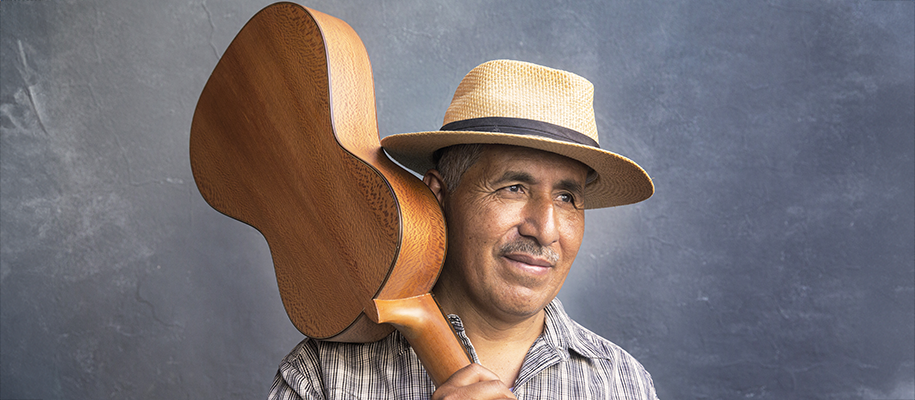It’s the first day of National Hispanic Heritage Month! Each year from September 15–October 15, this month-long celebration pays tribute to generations of Hispanic Americans who’ve made a positive impact on the US and the world around us. Below, we’re sharing five Hispanic humanitarian heroes you should know about who’ve made their mark on our nation. (Check out our las mujeres edition as well—we can’t forget them!)
1. César Chávez
César Chávez was a civil rights and farm labor activist as well as a leader. When Chávez was just 11 years old, his family lost their farm and became migrant farmworkers. He left school after eighth grade and began working in the fields alongside his family. Years later, after experiencing the trials and tribulations of life as a migrant farmworker, Chávez was happy to be recruited by Fred Ross, a community organizer who went on to form the San Jose chapter of the Community Service Organization (CSO) at the time. He spent 10 years with the organization, coordinating voter registration, leading campaigns against discrimination, and starting new chapters across the state of California. In 1962, he founded the National Farm Workers Association—in which the first official members were his wife and children. The organization would later become the United Farm Workers of America (UFW), which went on to become the first successful farmworkers union in American history.
In 1962, President John F. Kennedy offered Chávez the honor of being head of the Peace Corps for part of Latin America, but Chávez turned it down to embrace a life of voluntary poverty. Fighting for migrant farmworker rights was far more valuable to him than monetary wealth. He then went on to found the first credit union for farmworkers, affordable housing, a burial program, health clinics, day care centers, job training programs, two educational radio stations, and more.
Chávez was adamant that he and his fellow farmworkers should commit to nonviolence in their protests. Because of Chávez and millions of Americans who supported farmworkers by boycotting grapes and other products, California passed the landmark Agricultural Labor Relations Act of 1975. This was the nation’s first—and still only—law guaranteeing farmworkers the right to organize, choose their own union representative, and negotiate with their employers. Chávez spent the bulk of his life fighting for the disadvantaged, impoverished, and incredibly hardworking farmworkers of the United States. When he passed away in 1993, over 50,000 people attended his funeral services in Delano.
Related: How You Can Pursue Activism as a Student in High School and College
2. Roberto Clemente
Roberto Clemente was the first Latin American baseball player to rack up 3,000 career hits before his tragic death—but Clemente was so much more than just a baseball player. He was also a philanthropist who set out to improve the lives of Latin Americans, especially disadvantaged Puerto Ricans. Clemente was especially passionate about helping Latin American children. He regularly held free baseball clinics for kids from low-income families. He said of his charity work, “There is nothing wrong with our homes, our country, that a little more care, a little more concern, a little more love won’t cure.”
After Clemente tallied his 3,000th hit in 1972, a devastating earthquake hit Nicaragua. He decided to visit the country to deliver supplies, but the plane crashed on the way. It was New Year’s Eve, and Clemente was just 38 years old. He died doing what was most important to him: helping those who needed it the most. Each year since 1971, the MLB has given the Roberto Clemente Award to a player who demonstrates exemplary commitment to community service in honor of Clemente’s legacy.
3. Arturo Alfonso Schomburg
Arturo Alfonso Schomburg was an Afro-Puerto Rican historian, writer, and activist as well as a collector of literature, art, and other African artifacts. In 1891, Schomburg moved to Harlem and joined the Revolutionary Committee of Puerto Rico. He and the organization fought for Puerto Rico and Cuba's independence from Spain. Schomburg coined the term "Afroborinqueño" to celebrate his heritage as a Latino of African descent. Though he worked several jobs, he found his niche in identifying artifacts that disproved the notion that people of African descent hadn’t made notable achievements across the span of history—and writing about his discoveries. Schomburg's first article, "Is Hayti Decadent?" appeared in a 1904 issue of The Unique Advertiser.
In 1911, Schomburg established the Negro Society for Historical Research with John Howard Bruce to support the research efforts of African American, African, and Caribbean scholars. Schomburg was then appointed as the president of the American Negro Academy, which led to Schomburg co-editing the Encyclopedia of the Colored Race. Then in 1926, the New York Public Library purchased Schomburg's artifact collection to establish the Schomburg Collection of Negro Literature and Art at the 135th Street branch of the New York Public Library, of which Schomburg was the curator. Now called the Schomburg Center for Research in Black Culture, it remains one of the most notable collections focused on the African diaspora to date.
Related: Four-Year Colleges With African/Black Studies Programs
4. Ralph Lazo
During World War II, Ralph Lazo became the only known person of non-Japanese ancestry who volunteered to live in an internment camp alongside 110,000 people of Japanese descent—most of whom were American citizens. Lazo, a Mexican American, was born in a Black hospital in Los Angeles in 1924. He experienced discrimination in LA because segregation applied to both the Black and Latino communities at that time, in addition to experiencing it on the Native American reservation in Arizona where he lived for some time as a child.
In 1942, when Lazo was a teen, the United States corralled Japanese-American leaders with plans to congregate and evacuate Japanese people living on US soil, even if they were American citizens. Having many Japanese friends who were losing their homes, jobs, and lives, Lazo was heartbroken and horrified. When his Japanese-American friend jokingly suggested, “Why don’t you come along?”—he did. The person who took his information just assumed he was Japanese. He told the Los Angeles Times, “They didn’t ask...being brown has its advantages.” Lazo ended up at Manzanar, one of the 10 internment camps for Japanese Americans. While there, he was one of the most popular and beloved “campgoers.” Two years later, in August 1944, he was drafted into the United States Army and fought in the Pacific Theater. Ultimately, he survived both his time in the internment camp and his deployment, and his story made national news.
Lazo was one of only 10 donors who gave $1,000 or more to the lawsuit that led to the establishment of the Office of Redress Administration (ORA). The ORA administered a 10-year program to provide untaxed restitution payments of $20,000 to those Japanese Americans forced into internment camps. Ralph Lazo’s sacrifices for the cause and people in need won’t be forgotten.
5. Héctor P. García
Dr. Héctor Perez García was a surgeon, physician, World War II veteran, and civil rights activist. He was once described as "a man who in the space of one week delivers 20 babies, 20 speeches, and 20,000 votes." During World War II, Dr. Garcia served voluntarily in the US Army to provide free or low-cost medical aid to those who couldn’t afford it otherwise, becoming known as the "doctor to the barrios." In March 1948, Dr. Garica founded the American GI Forum of Texas, Inc. in Corpus Christi, Texas, to fight for the inclusion of Hispanic Americans. The Forum organized veterans to fight for educational equity and medical benefits.
In 1984, Dr. García was awarded the Presidential Medal of Freedom, making him the first Mexican American to receive the highest award an American civilian can obtain. He passed away in 1996, and since his passing, many schools, libraries, and government buildings throughout the state of Texas and the country have been named after him to honor his legacy. A statue of Dr. García on the Texas A&M University–Corpus Christi campus is adorned with his (and the American GI Forum) motto: "Education is our Freedom, and Freedom Should be Everybody's Business."
Related: 5 Questions to Evaluate Multicultural Commitment on Campus
We hope everyone finds some way this month to learn about Hispanic heritage and uplift their Hispanic friends and families. Hispanic immigrants and Hispanic Americans have contributed significantly to this country’s history and continue to today—and that should be celebrated this month and always. Happy National Hispanic Heritage Month, and be on the lookout for more special content into October.
Did we miss your personal hero? Well, they may just be in part two! Learn about 5 Hispanic Heroes Throughout History: Las Mujeres to get to know some incredible women.








